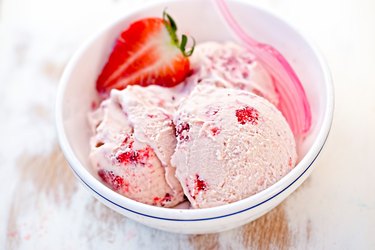
Ingredient labels should be informative. But when they contain vague phrases like "natural and artificial flavors," how much can they really tell us about our food?
Since literally thousands of chemicals fall under these umbrella terms, they may raise more questions than answers.
If you pay attention to the nutrition facts labels on packaged foods, you've probably seen the terms "natural flavors" or "natural flavorings" quite a bit. According to the Environmental Working Group's database of more than 80,000 foods, "natural flavor" is the fourth most common ingredient listed on labels, after just salt, water and sugar.
"Artificial flavors" and "artificial flavorings" are also prevalent in ingredient lists; sometimes, the combination term "natural and artificial flavors" also makes an appearance. Overall, more than 2,600 flavoring substances have been classified as "generally recognized as safe," aka GRAS, in the U.S. since 1960, according to the U.S. Government Accountability Office.
That doesn't mean, however, that these flavorings aren't without controversy or confusion. Here's what you should know about natural and artificial flavors, and why they matter to your health.
What Are Natural Flavors?
Something can be labeled as "natural flavor" or "natural flavoring" as long as its significant function is to provide flavor rather than nutritional value and it is derived from one of the following sources, according to the U.S. Electronic Code of Federal Regulations.
- Spices
- Fruits or fruit juice
- Vegetables or vegetable juice
- Edible yeast
- Herbs, bark, buds, roots, leaves or similar plant material
- Meat, seafood, poultry, eggs or dairy products
Despite their name, most natural flavors are still produced in a lab, explains Riley Thornton, RDN, a nutritionist and wellness specialist at the University of Alabama at Birmingham.
Scientists take a natural food source, like a fruit or spice, and they find ways to extract chemicals that capture that source's taste — but not its texture, fat content or calorie content. This could be an essential oil, a resin, an essence, a distillate or "any process of roasting, heating or enzymolysis," the government guidelines state.
Ingredient labels sometimes refer to the source of the flavor: "natural strawberry flavor," for example. They may not list a specific source, however, if a combination of different natural flavors is used. Some common examples of natural flavors include:
- Vanillin: This extract from vanilla beans is the most commonly used flavor ingredient in the U.S., according to the Flavor and Extract Manufacturer's Association (FEMA).
- Cinnamon bark extract: Known by the chemical names Cinnamomum zeylanicum Nees, Cinnamomum loureirii Blume, and Cinnamomum cassia Blume, these natural cinnamon flavors are produced through a chemical process called solvent extraction, according to a January 2020 report in Food and Chemical Toxicology.
- Limonene: This compound is found in the essential oil of orange and lemon peels, and provides citrus flavor and aroma to many foods, fragrances and cleaning products.
- Natural beef flavor: A somewhat surprising ingredient found in McDonald's french fries, this flavoring derived from beef also contains hydrolyzed wheat and hydrolyzed milk — which means the famous fries are not vegetarian, dairy-free or gluten-free.
You might think of the herbs and spices you add to your food as "natural flavors," but by the technical definition, that's not true. Under food labeling guidelines, any substances obtained "by cutting, grinding, drying, pulping or similar processing of tissues derived from fruit, vegetable, meat, fish or poultry," is considered food, rather than flavor.
In an ingredient list, these substances would be listed by their common names — onion powder or garlic powder, for example. The same goes for salt: Any natural salts, when added to a product, are listed as "salt" and not as "natural flavors."

What Are Artificial Flavors?
Artificial flavors are not so different from natural ones, according to FEMA. They are still created by chemical processes, but because of the source from which they're derived, they don't meet the requirements of a natural flavor.
In order for the flavoring in strawberry gum or ice cream to be labeled as a "natural flavor," for example, it must be derived from strawberries. If it's derived from anything else — even another plant or fruit — it must be labeled as "artificial flavor."
Artificial flavors can also be derived from inedible substances, like petroleum or wood pulp. In fact, many flavors that can be produced "naturally" can also be produced with "artificial" ingredients; the end chemical compounds (and the flavor that's produced) are identical, even though the original sources are different.
"Often it's less expensive and more environmentally friendly to create something in a lab, especially if the land or the proper climate is not readily available," says Kara Bowers, RD, a dietitian at Penn State College of Medicine.
Take vanilla extract for example: "Vanilla beans can only be grown in tropical areas and it's a very sensitive plant," Bowers says, "so it's often easier to recreate those flavors with other ingredients."
Some other examples of flavors that are often produced artificially include the following, according to the American Council on Science and Health:
- Diacetyl: a byproduct of fermentation that produces a butter-like flavoring, used in microwave popcorn
- Isoamyl acetate: the principal flavor in bananas, made by mixing alcohol with an acid
- Methyl anthranilate: a compound found in grapes (but more commonly made from petroleum) used to flavor grape candy and soda
Are Natural Flavors Healthier Than Artificial Ones?
When it comes to choosing between natural and artificial flavors, there's not much difference nutrition-wise. Neither natural nor artificial flavors contain calories, fat, sugars or vitamins and minerals.
Often, the chemical makeup of a natural and an artificial flavor can be exactly the same. And sometimes, according to the Environmental Working Group, artificial flavors actually have fewer chemicals than natural ones.
There is one thing that could cause a potential health risk, though: "If you have an allergy, it's important to check and see where those flavors — natural or artificial — are coming from," says Bowers. The FDA requires food manufacturers to list the eight major food allergens on food labels, she adds. But for people with less common allergies or intolerances, it may be necessary to get more information about ingredients that are vague or unclear.
Concern has been raised about some specific flavorings over the years. In the early 2000s, for example, diacetyl— a synthetic butter flavor — was found to cause lung damage in people who breathed it in while working at microwave-popcorn processing plants.
A December 2012 paper in Environmental Health Perspectives noted that, while some manufacturers switched to a different flavoring, health concerns exist about the new substitute, as well.
And in 2018, the FDA announced it was banning six chemicals that could be listed as artificial flavors and flavor enhancers because they'd been linked to cancer in laboratory animals.
"When you are buying packaged foods, look at the entire ingredient list. A good rule of thumb is to choose the items with the least number of ingredients and the least number of added chemicals, flavors and preservatives."
Overall, though, anything that falls under a flavor or flavoring has been classified as safe to eat, at least in the very small amounts present in our food. "Artificial flavors can get a bad rap thanks to unreliable, fear-mongering sources," says Bowers. "As a dietitian, I'm a big believer in facts, not fear."
But Thornton points out that if you're consuming a lot of natural and artificial flavors, it probably means you're consuming a lot of processed foods — which can be bad for your health for other reasons.
"When you are buying packaged foods, look at the entire ingredient list," she says. "A good rule of thumb is to choose the items with the least number of ingredients and the least number of added chemicals, flavors and preservatives."
"I do try to push people to consume as many natural, whole foods as possible," she adds. Whole fruits and vegetables, whole grains and lean meats don't contain added flavorings, she points out, nor do they need them.

What About MSG?
When people think about added flavorings in food, they often think of monosodium glutamate, or MSG. This additive is commonly found in soups, canned vegetables, Chinese food and processed meats, according to the Mayo Clinic.
MSG occurs naturally in some foods, including tomatoes and cheeses, according to the U.S. Food and Drug Administration. But it's also produced synthetically and added to packaged or prepared foods as a flavor enhancer.
As far as foods label goes, however, MSG won't be listed as natural or artificial flavors. Just as salt must be listed by its common name in ingredient lists, monosodium glutamate must be listed by name in the ingredients, as well.
Over the years, the FDA has received many reports of adverse reactions to MSG, including headache, sweating, numbness, fluttering heartbeats, chest pain and nausea. These reactions have become known as MSG symptom complex, but no published studies have found a definitive link between the additive and these specific symptoms, per the Mayo Clinic.
MSG is considered safe by the FDA, Thornton says. But even if people don't experience strange symptoms like those listed above, she says it's important to remember that it is a type of salt.
"A lot of Americans really need to watch their sodium intake because of blood pressure concerns," she says. "And even for people who don't have high blood pressure, we should be keeping in mind how much sodium is in the processed foods we eat."
MSG does contain less sodium than regular table salt, and when used in moderation, it may help people reduce their overall sodium intake. But instead of relying solely on salt-based products, Thornton recommends flavoring foods with herbs and spices, too.
Natural Flavors in Seltzer
One place the term "natural flavors" is seen today is on the ingredient label of fruity seltzer waters. These products have become very popular, thanks to their promise of fizz plus flavor without the calories.
But how can these claims claim be true — how can a "natural" product have the flavor of a fruit without the calories? That goes back to the science of flavor extraction, Thornton says. "It's possible to distill the essence of a fruit and include it in such small quantities that it doesn't contribute to the calories of a drink," she says.
Flavored seltzers made with natural flavors can certainly be a healthy alternative to drinking sugar-sweetened sodas or high-calorie fruit juices, Thornton says. But she does recommend reading the entire ingredient label carefully. "Sometimes a drink can be naturally favored but it can still contain artificial sweetener," she points out.
And while flavored seltzers make a nice treat, keep in mind that drinking carbonated water can cause unpleasant side effects for some people.
Thornton still recommends getting flavor from real foods — rather than chemicals — whenever possible. "Squeeze a lemon or some berries into your water, or flavor it with herbs like mint or rosemary," she says.
Related Reading